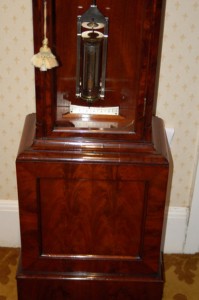The pendulum clock
The speed of the clock is the only thing that controls timekeeping. Adjusting the pendulum will make the clock go faster or slower. All other factors can be considered constant. This can be seen from the equation relating to the period of swing of a simple pendulum.
T = 2π√(L/g)
where
- T is the period in seconds (s)
- pi = 3.14 (it is also written as the Greek letter π)
- L is the length pendulum in meters or feet
- g is the acceleration due to gravity (9.8 m/s² or 32 ft/s²)
Lengthen pendulum to go slower and vice versa
If your antique clocks are correctly set up and are fast and gaining time, you will need to lengthen the pendulums. If your clock is slow, you will need to shorten the pendulum of the clock, to quicken it up.
All clock pendulum rods and bobs prior to the temperature compensated pendulums either will expand or contract with temperature changes. They need to be adjusted accordingly. Most antique clocks in centrally heated houses will be re-markedly accurate though, after you have adjusted to your mean temperature.
Temperature Compensated Pendulums on Clocks
Probably the earliest method for trying to overcome deviations in timekeeping as a result of temperature changes was the wood rod pendulum. In long grain the wood rod will expand only a little.This expansion will be compensated by the addition of a large brass cased lead bob. This brass bob will also expand slightly up and down from the rating nut, with temperature changes.
Every Increasing Accuracy
Refining the accuracy of the very best precision clocks started from the early 18th century with Harrison’s grid iron pendulum. Differing expansions of metals was understood many years earlier. Harrison devised a pendulum with a specific proportion of brass and iron. These two metals would have rates of expansion and contraction that would effectively cancel each other out.
George Graham
In 1722 Graham produced a mercury compensated pendulum. The mercury as seen in a regulator clock in the picture above is contained in a jar. This is effectively acting the same as a normal brass pendulum bob. Mercury will expand roughly 6 times the rate of steel and so in the ratio 1:6. The expansions will roughly cancel each other out. The thermal coefficients of the differing metals is therefore important when building compensated pendulums. Glass being a poor conductor of heat was the only real negative to this invention but this method proved very effective and the pendulums do look stunning. These type of clocks are very collectible.
John Ellicott
There were various other pendulum’s developed like Ellicott’s compensated pendulum and Richie’s compensated pendulum on regulator clocks.Then the eventual use of metals like Invar which is a mix of nickel/iron and small quantities of carbon and manganese.
Conculsion
All these compensated pendulums are just trying to keep the effective length of the pendulum the same. When I say effective length of the pendulum, this will be from the bending point of the feather at the top of the clocks pendulum, to the centre of gravity of the pendulum near its bottom. This is why on some clocks coins or small weights were added on the rod to change fine timekeeping. I will happily answer more question if you contact me.


